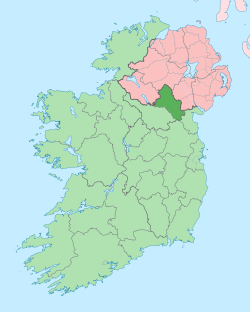Tassan
Tassan (Irish: An tEasán) is a townland in the parish of Clontibret in County Monaghan, Ireland.
Tassan Tasson | |
|---|---|
Townland | |
 Tassan Location in Ireland | |
| Coordinates: 54°11′10.03″N 6°47′33.2″W | |
| Country | Ireland |
| Province | Ulster |
| County | County Monaghan |
| Time zone | UTC+0 (WET) |
| • Summer (DST) | UTC-1 (IST (WEST)) |
Townland
The townland of Tassan or Tasson is situated approximately two miles north east of Annyalla, close to the border with Northern Ireland, between the towns of Monaghan and Castleblayney, off the old N2 National primary road, which linked Dublin and Derry. It has a rich history of local characters many of whom acquired their local knowledge and traditions from generations who have passed on. The area is located close to the Armagh border which provided an option for people to make a living during periods of economic recession also the Cashel and Tonagh bogs supplied a constant source of fuel to people for many years up to the late 1960s. Two lakes dominate the landscape in the townland, Lough Nahinch (The Island Lough) and Tassan Lough Natural Heritage Area both of which have been used by anglers for pike and perch fishing over the centuries.
History
Tassan is located in the postal district of Clontibret where in 1595 in the adjacent countryside the Battle of Clontibret occurred. The territory of Monaghan had been wrested from the control of the MacMahon clan in 1591, when the clan leader was executed by English authority. Subsequent encroachments by the English into the province of Ulster led to the Nine Years War (1595–1603). The battle was the earliest clash between the two sides, with the Irish led by Hugh O'Neill and the English by Sir Henry Bagenal. Although O'Neill won the battle, the war ended with the completion of the English conquest of Ireland. In 1610 the Plantation of Ulster was established, an event that still defines certain political allegiances in the north of Ireland.
The Tassan Mining Company
The Tassan Mining Company was established in the late 1840s and is recognised as one of the largest and most productive lead mines in County Monaghan. Total production was reported at 742 tonnes of ore, including 546 tonnes of lead and 37.478g of silver. The mineralization was hosted by two lodes each striking Northwest and dipping Eastwards.[1] The mine appears to have extended to a depth of 160 m below surface, the site contained a combined engine and crusher house as well as mine offices, workshops and at least five shafts.[2] The lead mine continued in operation until 1865-1866, after which production statistics are unavailable, it would have provided much needed work locally in the aftermath of the potato famine which greatly impacted the population of Tassan and its environs. The Captains' Mine offices remain standing and the site is largely grassed over with spoil heaps visible near Tassan Lough Natural Heritage Area.[3]
Tassan Rovers GAA team 1937 to 1941
The Tassan G.A.A. team was founded at the beginning of 1937 and participated in the Junior League Mid Monaghan section. The team's early success in the League attracted the attention of young local talent and skilled players from neighbouring areas who wanted to play competitive team football. The Tassan team progressed to the top of their division in the Junior League by the end of June 1937. The main article link above "Tassan Rovers GAA", traces the progression of the Tassan Team from their formation in early 1937, to their success in winning the 1939, Dr. Ward Cup Final re-play against Killanny, which was held in Castleblayney on Sunday 21 April 1940. The article concludes with Tassan team re-union held in April 1977 and presentation of the Dr. Ward Cup medals, 37 years after the cup competition.
People
- Roman Catholic Archbishop Sylvester Mulligan was born in Tassan, Clontibret, County Monaghan, on 12 Mar 1875 and was educated at the Capuchin College, Rochestown, County Cork, and at Louvain. In 1892 he entered the Capuchin Order and was ordained in 1901. He taught moral theology at Louvain and in 1925 was elected Minister Provincial of his order, a year later becoming Definitor General. In 1937 he was the last non-Indian to be appointed to Delhi-Simla as archbishop. For a period he was editor of the Father Mathew Record. He died on 23 Oct 1950 and is buried in the Capuchin plot in Glasnevin Cemetery, Dublin.[4]
- Roman Catholic Bishop Brendan Comiskey, former Bishop of Ferns, County Wexford, was born in Tassan, Clontibret on 13 August 1935. He was auxiliary Bishop of Dublin from 1980 until his appointment to Ferns in 1984. He resigned as Bishop of Ferns in 2002.
- Father Tony Prunty, SPMS, of Kiltegan Missionaries Kenya was born in Tassan.[5]
- Brother Thaddeus (Pat) Brennan, CSSR Redemptorist Dundalk was formerly from Tassan.
- Senator John Brennan, a Fianna Fáil member of Seanad Éireann from 1960 until 1977 and a member of Monaghan Co Council from 1942 until 1974 was also from Tassan, Clontibret.
References
- (Morris J.H 1984 : The Metallic Mineral Deposits of the Lower Palaeozoic Longford-Down Inlier in the Republic of Ireland Geological Survey of Ireland RS 84/1 Mineral Resources, pp72)
- (Morris J.H., Lally, P. and Cowman, D. (2002). A history and survey of mine buildings at the Tassan Mine Co. Monaghan. Journal of the Mining Heritage Trust of Ireland 2, 41-49)
- "Monaghan: County Geological Site Report: Tassan" (PDF). Geological Survey of Ireland. Retrieved 24 August 2017.
- Cheney, David M. "Archbishop Sylvester Patrick Mulligan [Catholic-Hierarchy]". www.catholic-hierarchy.org. Retrieved 24 August 2017.
- "HoganStand.com". www.hoganstand.com. Retrieved 24 August 2017.
